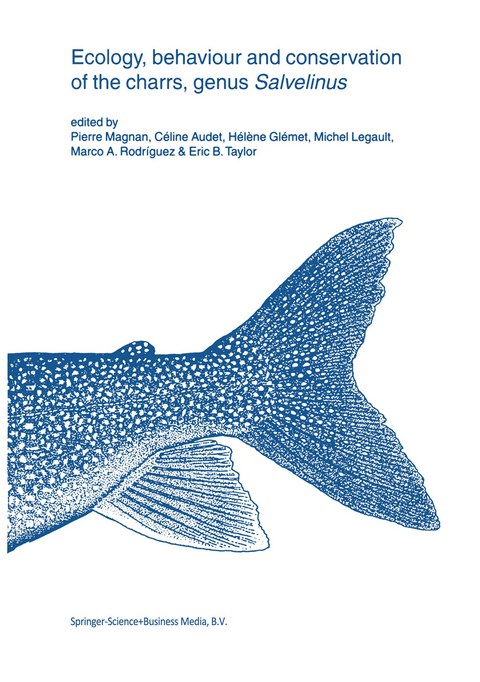
Ecology, behaviour and conservation of the charrs, genus Salvelinus
Springer-Verlag New York Inc.
978-1-4020-0784-2 (ISBN)
Prelude.- Developments in the ecology, evolution, and behaviour of the charrs, genus Salvelinus: relevance for their management and conservation.- Keynote.- Charrs, glaciations and seasonal ice.- 1. Ecological interactions and behaviour.- Takvatn through 20 years: long-term effects of an experimental mass removal of Arctic charr, Salvelinus alpinus, from a subarctic lake.- Spatial and temporal variability in the diet of anadromous Arctic charr, Salvelinus alpines, in northern Labrador.- The relationship between spatial distribution and diet of Arctic charr, Salvelinus alpines, in Loch Ness, U.K..- Growth and dietary niche in Salvelinus alpinus and Salvelinus fontinalis as revealed by stable isotope analysis.- Does the refuge availability influence the spawning behavior of mature male parr in salmonids? A test in the Miyabe charr.- 2. Trophic polymorphism.- Diversification, sympatric speciation, and trophic polymorphism of Arctic charr, Salvelinus alpinus complex, in Transbaikalia.- The biology of Arctic charr, Salvelinus alpinus, of Gander Lake, a large, deep, oligotrophic lake in Newfoundland, Canada.- Physiological performance of two forms of lacustrine brook charr, Salvelinus fontinalis, in the open-water habitat.- 3. Movements and migrations.- Why do foraging stream salmonids move during summer?.- Local movement as a measure of habitat quality in stream salmonids.- Adaptations to stochastic environmental variations: the effects of seasonal temperatures on the migratory window of Svalbard Arctic charr.- Seasonal timing and diel activity of lacustrine brook charr, Salvelinus fontinalis, spawning in a lake outlet.- 4. Ecophysiology and evolutionary genetics.- Seasonal changes in osmotic and ionic regulation in Arctic charr. Salvelinus alpinus. From a high- and a sub-arctic anadromous population.- The effect of acute stress and temperature on plasma cortisol and ion concentrations and growth of Lake Inari Arctic charr, Salvelinus alpinus.- Phenotypic differences in buoyancy and energetics of lean and siscowet lake charr in Lake Superior.- A sex-linked microsatellite locus isolated from the Y chromosome of lake charr, Salvelinus namaycush.- Interspecific relationships among charrs based on phylogenetic analysis of nuclear growth hormone intron sequences.- Characterization of charr chromosomes using fluorescence in situ hybridization.- Physiological, endocrine, and genetic bases of anadromy in the brook charr, Salvelinus fontinalis, of the LavaI River (Québec. Canada).- 5. Ecological parasitology.- A comparative study of Eubothrium salvelini and E. crassum (Cestoda: Pseudophyllidea) parasites of Arctic charr and brown trout in alpine lakes.- Parasite-induced host mortality: indirect evidence from a long-term study.- 6. Environmental stress and conservation.- A comparison of Floy and soft Vlalpha tags on hatchery Arctic charr, with emphasis on tag retention, growth and survival.- The effect of Carlin tags on survival and growth of anadromous Arctic charr. Salvelinus alpinus.- Abundance, annual survival, and recruitment of unexploited and exploited lake charr, Salvelinus namaycush, populations at the Experimental Lakes Area, northwestern Ontario.- Biomass and production of lake charr during the acidification and pH recovery of a small Ontario lake.- Assessment of the feasibility of preventing reproduction of lake charr, Salvelinus namaycush, in shallow areas of reservoirs affected by drawdowns.- The relevance of individual size to management of Arctic charr, Salvelinus alpines, populations.- Decline of the migratory form in bull charr,Salvelinus confluentus, and implications for conservation.- Factors affecting redd site selection, hatching, and emergence of brook charr, Salvelinus fontinalis, in an artificially enhanced site.- Impact of the 1998 El Niño event on a lake charr, Salvelinus namaycush, population recovering from acidification.- Species and subject index.
| Erscheint lt. Verlag | 31.7.2002 |
|---|---|
| Reihe/Serie | Developments in Environmental Biology of Fishes ; 22 |
| Zusatzinfo | 6 Illustrations, color; 53 Illustrations, black and white; 360 p. 59 illus., 6 illus. in color. |
| Verlagsort | New York, NY |
| Sprache | englisch |
| Maße | 178 x 254 mm |
| Themenwelt | Naturwissenschaften ► Biologie ► Evolution |
| Naturwissenschaften ► Biologie ► Ökologie / Naturschutz | |
| Naturwissenschaften ► Biologie ► Zoologie | |
| ISBN-10 | 1-4020-0784-1 / 1402007841 |
| ISBN-13 | 978-1-4020-0784-2 / 9781402007842 |
| Zustand | Neuware |
| Haben Sie eine Frage zum Produkt? |
aus dem Bereich


